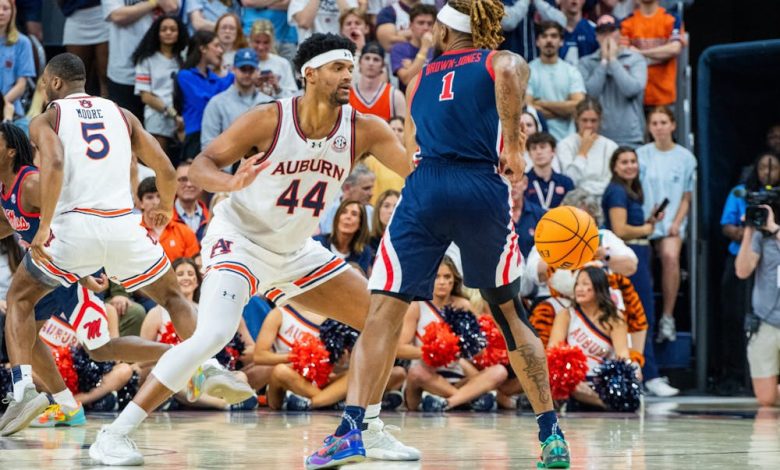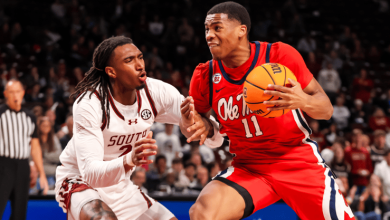Important statistics: No. 1 Auburn defeats Ole Miss 106-76 to finish a perfect home stand.

In college basketball, every win is important, but some victories stand out for their magnitude, the quality of play, and the significance they carry for the team’s postseason aspirations. When No. 1 Auburn took on Ole Miss in a highly anticipated matchup, the Tigers did not just claim another win—they made a statement. In front of their home crowd, Auburn ran away with a dominant 106-76 victory, completing a perfect home stand with a decisive triumph that showcased the depth and power of Bruce Pearl’s team.
For Auburn, this victory was more than just a lopsided win; it was a culmination of weeks of hard work, strategic execution, and individual brilliance that demonstrated why they deserved their top ranking. As they now look toward the rest of the season and the SEC Tournament, this game will be one they look back on as a blueprint for success. To truly understand the full extent of Auburn’s performance, let’s take a deep dive into the most important statistics from the game, exploring what these numbers reveal about the Tigers’ dominance and what they mean moving forward.
1. Auburn’s Scoring Explosion: 106 Points Scored
The most obvious and eye-catching statistic from Auburn’s 106-76 victory was the final score. Scoring 106 points in a college basketball game is no small feat, especially against an SEC opponent like Ole Miss. Auburn’s ability to reach the 100-point mark was a reflection of their offensive efficiency, pace of play, and scoring balance. It’s also worth noting that Auburn’s 106 points were the highest they’ve scored all season, an indicator that the team was clicking on all cylinders.
Auburn’s offensive output was not the result of a single player going off for a career-high but rather a collective effort that saw multiple players contributing at a high level. The Tigers shot 52.9% from the field, converting 41 of their 77 field-goal attempts, a testament to their fast pace and the high percentage shots they were able to generate. Their ability to move the ball and create open looks, whether from beyond the arc or in the paint, allowed them to exploit Ole Miss’ defensive weaknesses.
This offensive explosion was a stark contrast to the struggles of Ole Miss, who were outpaced and outclassed by Auburn’s high-powered attack. Auburn pushed the tempo all game long, capitalizing on fast-break opportunities and forcing Ole Miss into defensive breakdowns. The Tigers’ ability to score in a variety of ways—from transition buckets to inside finishes to perimeter shooting—kept the Rebels on their heels all game long.
The high-scoring output is also indicative of Auburn’s unselfishness on offense. The ball movement was fluid and purposeful, as players regularly looked for the best possible shot rather than forcing bad attempts. The fact that Auburn scored 106 points while maintaining such offensive balance speaks volumes about the chemistry and cohesion of the team.
2. Dominance in the Paint: 56 Points in the Paint
A key factor in Auburn’s overwhelming victory was their dominance in the paint. Scoring 56 points in the paint against Ole Miss was a clear reflection of Auburn’s ability to assert their size and athleticism. In the first half alone, the Tigers relentlessly attacked the rim, taking advantage of their height and physicality to get easy baskets inside. Whether it was through post-ups, drives to the basket, or offensive rebounds, Auburn controlled the interior game with authority.
One of the primary reasons Auburn was able to dominate in the paint was the presence of their star players, Walker Kessler and Jabari Smith. Kessler, in particular, was a force in the middle, not only scoring efficiently but also protecting the rim, which discouraged Ole Miss from trying to challenge him inside. Kessler’s 7-foot-1 frame allowed him to tower over Ole Miss defenders, and he took full advantage, finishing around the basket with ease.
Jabari Smith, while known for his versatility as a shooter and defender, also showcased his ability to get inside and score. His length and athleticism allowed him to finish through contact and create mismatches against smaller defenders. As the game wore on, it became evident that Ole Miss had no answer for Auburn’s big men, and the Tigers continued to exploit that advantage.
Auburn’s ability to dominate the paint was also helped by their rebounding effort. The Tigers grabbed 46 total rebounds, with 16 of those coming on the offensive glass. This allowed them to continue attacking the rim on second-chance opportunities. With Kessler and Smith leading the way, Auburn was able to secure numerous offensive boards and convert them into easy points, further piling on the pressure against Ole Miss.
3. Three-Point Shooting: 14-27 (51.9%) from Beyond the Arc
While Auburn’s interior game was impressive, their shooting from beyond the arc was equally significant. The Tigers shot 51.9% from three-point range, making 14 of their 27 attempts. This high shooting percentage was crucial in keeping the defense spread out, creating more driving lanes, and providing Auburn with additional weapons on offense.
Jabari Smith, who is known for his ability to stretch the floor, was particularly effective from beyond the arc, knocking down 4-of-6 three-pointers. His shooting touch is one of the key elements of his game, as it forces defenders to close out hard on him, which opens up other parts of Auburn’s offense. His ability to shoot with consistency from long range has made him a matchup nightmare, and Ole Miss struggled to contain him on the perimeter.
Wendell Green Jr. also played a significant role in Auburn’s success from three-point range, making 3-of-4 from deep. Green’s quick release and ability to create his own shot off the dribble make him a dangerous weapon, and Ole Miss had no answer for his offensive versatility. Green’s ability to hit from distance helped space the floor for Auburn, allowing them to keep the pressure on Ole Miss both inside and out.
The sharp shooting from Auburn did more than just provide points; it stretched Ole Miss’ defense, forcing them to cover more ground and leaving them vulnerable to Auburn’s fast breaks and offensive rebounds. With Auburn hitting shots from all over the floor, it became nearly impossible for Ole Miss to defend in a way that could contain the Tigers’ potent attack.
4. Auburn’s Bench Contribution: 30 Points from the Bench
Another key statistic that contributed to Auburn’s success was the depth of their roster. The Tigers’ bench contributed 30 points in the game, a significant figure that speaks to the team’s depth and ability to rely on multiple players throughout the contest. The ability to get such a strong contribution from the bench allowed Auburn to keep fresh legs on the floor, particularly when the pace of the game was quick and high-scoring.
Players like Alan Flanigan and KD Johnson provided crucial minutes off the bench, offering scoring and defensive energy when the starters needed rest. Flanigan, who has been dealing with injury setbacks, has shown flashes of his potential when healthy, and in this game, he contributed key minutes, adding depth to Auburn’s already loaded roster. Johnson, known for his feisty defense and offensive spark, was key in maintaining the Tigers’ momentum, scoring efficiently and defending hard.
The balanced contributions from the bench meant that Auburn could rest their star players without losing a significant lead or rhythm in the game. With so many capable players on the roster, Auburn is a team that can sustain their level of play throughout the game, making them a difficult opponent to face for any team in the SEC or beyond.
5. Turnovers: Auburn’s Controlled Offense, Just 8 Turnovers
While many teams struggle with turnovers in high-paced games, Auburn showed impressive control on offense, committing just 8 turnovers for the entire game. Their ability to take care of the basketball while simultaneously pushing the tempo and scoring efficiently is a testament to the maturity of the team.
Wendell Green Jr. and Zep Jasper did a great job of running the offense, ensuring that Auburn’s fast breaks and transition offense were fluid without risking careless mistakes. The Tigers’ ability to share the ball and create good shot opportunities without turning it over was crucial in maintaining their lead and ensuring that Ole Miss had no chance to mount a serious comeback.
This low turnover rate also allowed Auburn to get more shot attempts and limit the Rebels’ offensive possessions. By controlling the ball, Auburn was able to dictate the flow of the game and keep the pressure on Ole Miss at all times.
6. Auburn’s Defensive Effort: Limiting Ole Miss to 76 Points
While Auburn’s offensive display was dominant, their defense was equally effective. Although Ole Miss managed to score 76 points, much of their offense came in garbage time when the game was already out of reach. Auburn’s defensive effort was characterized by stifling man-to-man coverage, excellent help defense, and efficient rebounding.
Walker Kessler was once again a key factor in the Tigers’ defense, providing rim protection and altering shots throughout the game. His size and ability to contest shots at the rim made it nearly impossible for Ole Miss to get clean looks inside. Along with Kessler, Auburn’s perimeter defenders did an excellent job of forcing Ole Miss into tough, contested shots, particularly from beyond the arc.
The Rebels shot just 39.3% from the field and 29.6% from three-point range, both below their season averages. This defensive dominance was one of the key reasons Auburn was able to maintain control of the game throughout.









